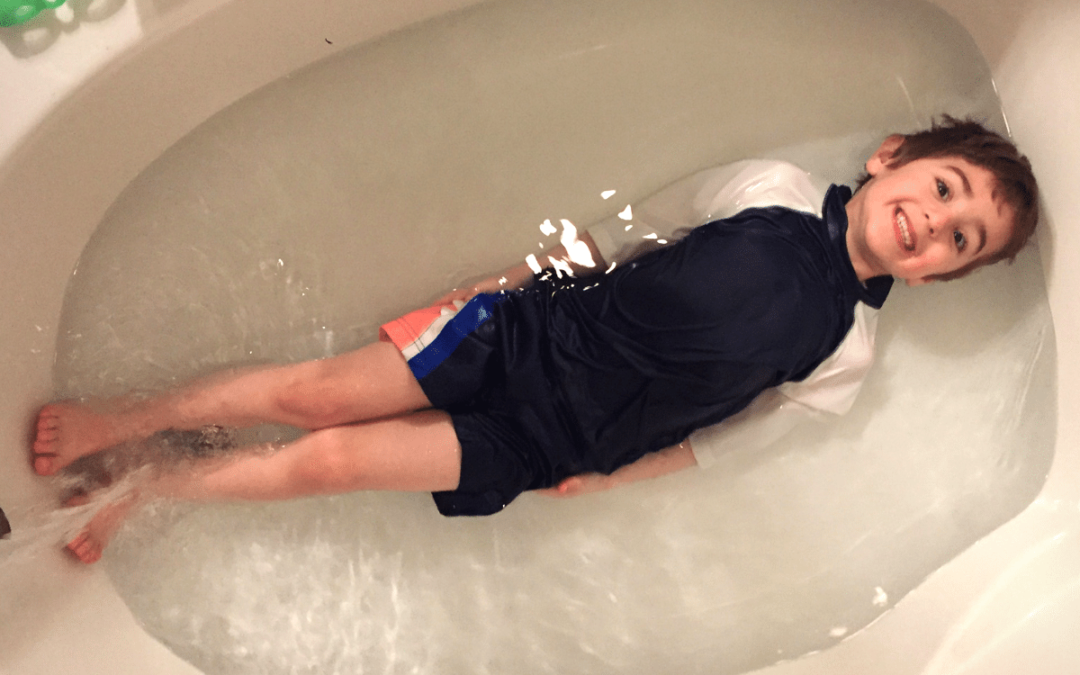Are you looking for a way to keep up with those swimming lesson skills while we’re all away from the pool? Aquatics Director Nicole Bills put together a fantastic list of things to practice at home––either on dry land or in your bathtub. Read on for descriptions of the exercises and be sure to follow us on Facebook, Instagram, and Twitter: we’ll share photos and videos with a few demonstrations this week.
The best suggestion we can offer parents is to make sure you respond with praise and excitement as your child tries these skills. Your child’s enjoyment of the water is the most important skill to learn as they get ready for or continue with swim lessons. Including games, songs, toys, and your own praise and happiness during bath time with your child will help them learn to love the water and be excited to return to the pool when we are able.
General Bathtub Tips
- We love for children to practice wearing their goggles in the bathtub. Getting comfortable wearing them there will make the transition to wearing goggles during swim lessons much easier!
- Allow your child to interact with toys in the tub. This helps their motor skills in the water, and most importantly, promotes their excitement and enjoyment in the water, which are incredibly important in learning to swim.
- Practice some of the verbal cues we use during swim lessons, such as, “kick, kick, kick!” or “splashing, splashing.” Helping your child to be familiar with these cues now will further their learning in the pool setting.
Bubble and Breathing Progression
One of the foundational lessons our swimmers learn is how to blow bubbles in the water. Blowing bubbles is key for learning how to be comfortable under the water and eventually learning how to breathe while swimming. The following five exercises (one on land and four in the bathtub) are a great way for your swimmer to get comfortable putting their face in the water and feeling confident in their bubbles.
- Fill a tall glass with about ½ cup of water. Give your swimmer a straw and have them blow bubbles in the glass. The glass will let them see the bubbles and helps mimic what we want them to do in the pool.
- Pour water over your child’s head. Make sure you let your child know you are going to pour the water — offer a countdown, or “here we go!”. Let the water run over your child’s face to help them get used to the feeling of being underwater.
- Ask your child to “kiss the water.” This helps your child get used to putting their face in the water.
- Once your child is comfortable with getting their face wet, encourage them to blow bubbles with their entire face in the water. Check out the penny game below for a fun way to do this!
- Ask your child to put their head in the water and hold their breath or blow bubble until you tap their head. The tap signals when they should bring their head out to breathe before going back under. Have your child turn their head to the side, take a breath, and put their face back in.
Penny Game
Help your child feel comfortable blowing bubbles and submerging by putting pennies at the bottom of the bathtub. Every penny they bring up while their face is in the water and blowing bubbles they get to keep.
Back Float
An important part of learning to swim involves your child being comfortable on their back with water surrounding them. You can help your child get used to this sensation by starting with just a small amount of water in the bathtub and laying your child on their back. As your child gets more comfortable, raise the level of the water high enough for your child to lay on their back with the water covering their body and ears, keeping their face above the water line. This skill is best practiced slowly and progressively, and often takes time and patience before your child will feel comfortable.
Windmill Arms
Having a strong stroke is important in making effective forward movements in the water. While standing up on dry land, practice making windmill motions.
- Starting with the right arm, have your swimmer swing their arm straight back, then straight up pressed against their ear, then extend straight out in front to pull the arm back down and return to the starting position.
- Repeat on the left side.
- Emphasize keeping arms straight and close to the head.
- Encourage your swimmer to keep their fingers together, ready to “cup” the water.
Leg Kicks
Learning how to kick is often the first mechanical swim technique a young child will learn, and is the most important part of propelling through the water. To practice on dry land, have your swimmer lie down on the ground on his or her belly. Have your child raise their right leg first, then their left leg –– without bending their knees. Have them go slowly at first to ensure correct form. You can make a game by putting your hand above their feet for them to try to tap as they go higher and higher. This skill can be practiced on their backs, as well. Just remember: straight legs!
If you try any of these exercises at home — share them with us! Tag @carmelswimacademy on Instagram and Facebook or @carmelswimacad on Twitter to show us your child’s moves! Have fun. We look forward to seeing you back at the pool soon.
